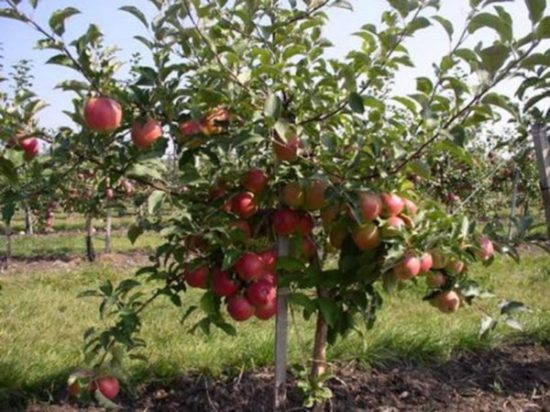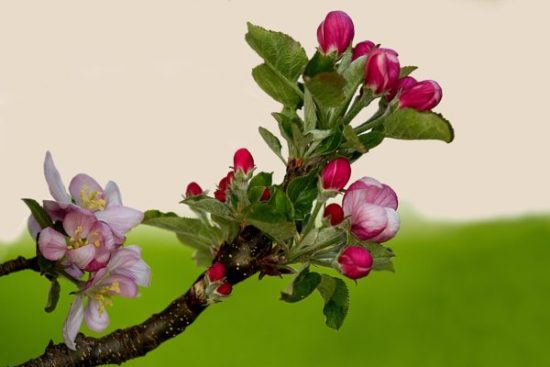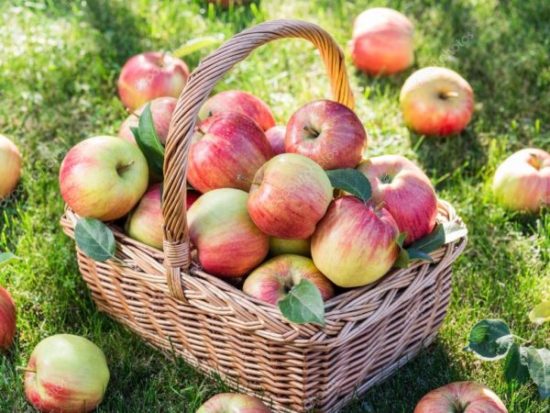Apple trees should bear fruit every year
Why do apple trees in the orchard sometimes bear fruit poorly and what needs to be done to increase the productivity of the apple orchard? In addition to pests and diseases, growing fruits are threatened by frost, strong winds, hail, and branches breaking under the weight of apples.For annual fruiting, the harvest needs to be rationed, but most often poor fruiting is the result of gardener mistakes.
| Content:
|
|
Gardeners make many mistakes when planting seedlings. As a result, the trees produce poor harvests or even die within a few years. Most often this is the deepening of the root collar. |
Reasons for poor fruiting of apple trees
Apples will ripen without care, but significant loss is possible at different stages of ripening. Timely and competent care will help increase the productivity of apple trees and preserve the harvest.
Weather vagaries can reduce apple harvest
Poor fruiting of apple trees is often caused by bad weather conditions.
Frost. Late spring (in the southern regions) and early summer (in the central and northern regions) frosts are dangerous for apple trees.
The sensitivity of buds, flowers and young ovaries to frost varies. Unopened buds can withstand short-term drops in temperature down to -4°C, flowers up to -2-2.5°C, and young ovaries only -1.5-2°C. Buds and flowers caught in frost fall off. The young ovary, in most cases, also crumbles. But some single ovaries can develop and turn into small apples. These apples are smaller in size, have no seeds (they died when frozen), and their taste is no different from ordinary apples.
When there is a threat of frost, fruit trees are watered abundantly. Watering increases soil and air moisture and reduces the likelihood of a strong drop in temperature. If there is a slight frost, deep watering can even help prevent it.Watering during the budding period delays the flowering of apple trees for a week, which allows you to survive the unfavorable period without significant losses.
|
A poor harvest often occurs after spring frosts |
The temperature drops most strongly near the ground and at a height of 1.5-2 m. The higher, the less the temperature drop. Therefore, frosts are most dangerous for low-growing and semi-dwarf trees. If there is a threat of freezing, they are covered with spunbond or lutrasil. Covering material increases the temperature inside the crown by 3-4°C. During weak and short mornings, this measure allows you to preserve all the flowers and ovaries, and therefore the harvest.
Caring for tall apple trees in this case is difficult. 40% of their flowers and ovaries are located exactly at a height of 2-3 m. There is no way to cover them. We can only hope for a lucky break.
All protective measures are effective only with a short-term drop in temperature. In case of prolonged frosts (more than 3 hours), any measures are powerless.
Strong winds. They knock down flowers, ovaries and filling fruits. If constant winds blow in the region, then the apple tree needs to be protected in the form of a hedge or windbreak. For low-growing varieties, 2-3 rows of raspberries and a row of currants are good. Tall varieties are always planted under the protection of a fence or buildings (house, barn, bathhouse, garage, gazebo, etc.). In areas with strong seasonal winds, slate forms of apple trees are grown, which are not afraid of the strongest winds.
Do not miss:
Broken branches. Branches break either from the wind or from the weight of the crop. As a rule, the wind breaks branches that extend from the trunk at an angle of less than 45°. This is always traumatic for the tree and leads to either severe wounds or the formation of a hollow.Therefore, when pruning, remove all branches that extend at an acute angle. The sharper the angle, the sooner the branch must be removed. If it is impossible to remove it, it is transferred to a horizontal position for several years.
|
If the branches are overloaded with apples, supports are placed under them. |
One support per 10 kg of apples. It is installed closer to the end of the branch, the lower end is firmly pressed into the ground. If there are a lot of apples on a branch, then two supports are placed: one in the middle of the branch, the other closer to its end.
From hail there is no special protection. Not only fruit trees suffer from it, but the entire area in general. Fortunately, it doesn't happen that often. Some apples damaged by hail fall, some ripen, but they cannot be stored. Hail-damaged fruits rot during storage, so they are processed after harvesting.
Frequency of fruiting
The frequency of fruiting is most pronounced in pear and apple trees. But in apple trees it is more pronounced.
The frequency of fruiting is the alternation of fruitful years with years of “rest”, when the apple tree does not bear fruit at all or produces very few apples.
The frequency depends on the variety. Some varieties have a pronounced periodicity (Antonovka, Grushovka, Borovinka, etc.). Others, on the contrary, tend to bear fruit more regularly; very fruitful years simply alternate with less fruitful ones, but there are still apples (Aport, Pepin saffron, etc.). Old Soviet varieties are more prone to periodic fruiting. In modern varieties it is not so pronounced; fruitful years simply alternate with less productive ones. But without care, even modern varieties will not bear fruit every year.
The reasons for the frequency of fruiting are:
- all plastic substances are directed to the growth of fruits, and there are no reserves left for the formation of flower buds;
- ripening of apples, especially in autumn and winter varieties, occurs late and the apple tree does not have time to lay flower buds;
- the next year there is no harvest, and the apple tree lays an excessive number of fruit buds, and in another year there will again be an overload of apples, and the tree does not have enough strength to lay fruit buds.
But usually young apple trees bear fruit annually, and frequency begins to appear only with age. This is due to the fact that there are not many fruits on young trees yet and there is enough strength for both fruiting and planting the future harvest.
The frequency of fruiting is highly pronounced with poor care and is significantly reduced with proper agricultural technology. It is necessary to ensure an annual growth of at least 30-40 cm. To achieve this, good fertilizing and watering are given in good years.
- Mostly foliar feeding is carried out. This enhances the formation of plastic substances by leaves, which allows them to be used for laying the future crop. There should be at least two feedings, one of them in early autumn.
- Do additional watering. In dry summers, be sure to carry out 3 additional waterings. In humid conditions - one at the end of summer. And only in very wet summers do they not water.
- Trimming. Rejuvenation and shortening of branches is carried out in lean years, since its main goal is to obtain good growth. General thinning of the crown is carried out in productive years, since old branches are removed, too much yield is reduced and some of the plastic substances remain for laying the next year's crop.
And of course, you shouldn’t delay harvesting apples.Then the trees will have both time and plastic substances to lay flower buds, and next year the apple trees will bear fruit well.
Delayed fruiting
It happens that an apple tree, despite good care, does not bear fruit.
- First, you need to find out from what year the variety begins to bear fruit. Old varieties (Streifling, Antonovka, Pepin saffron, etc.) begin to bear fruit in 8-10 years. Modern varieties begin to bear fruit in the 4th-5th year, and apple trees on dwarf rootstocks and columns - in the 2nd year.
- Secondly, on poor soils with poor care, even early-fruiting varieties begin to bear fruit 1-2 years later.
- Thirdly, the climate in the growing region may not be suitable for the apple tree. Summer residents often bring varieties from the south that are not suitable for the given area. The tree can grow, but cannot produce crops under these conditions.
However, if an apple tree is suitable for a given region and is well cared for, but it does not think about starting to bear fruit, then the reasons are different.
- Deepening the root collar during planting. As sad as it may be, this may only become clear in 10-12 years. You will have to dig up the root collar, and then wait another 2-3 years until it begins to bear fruit. But you can notice this much earlier. Before the apple tree begins to bear fruit, it produces a certain amount of fruit (5-7-10 pieces). If there was not a single apple in the entire time before the set date for the start of fruiting, this is a reason to worry and dig up the root collar much earlier.
- The crown was practically not formed and most of the branches grow almost vertically. The fruits are laid on branches that grow more or less horizontally. Therefore, there will be no harvest if the branches are not tilted horizontally.In advanced cases, only a portion of the branches are transferred to the horizontal plane annually. To do this, drive a stake into the ground, directed away from the apple tree, and tie a branch to it, in the same position it is left to overwinter. The next year the rope is pulled tighter, deflecting the branch even more. Many tops appear on branches transferred to a horizontal position. They are either cut into a ring or also transferred to a horizontal position, forming a semi-skeletal branch.
- Sometimes in very poor soils, apple trees lack iron. The most effective way is to bury several tin cans under a tree. Bury to a depth of 20-25 cm around the perimeter of the crown. The jars are pre-fired because they are treated with a special coating and do not decompose in the ground for a long time. A less gentle, but faster way is to hammer 2-3 nails into the trunk.
- Apple fattening. Often found on black soils among inexperienced summer residents. Chernozem is a land rich in nutrients, including nitrogen. If an apple tree in such soil is fed with nitrogen twice a season, it will not produce flower buds. Why should she overwork herself, she’s doing just fine as it is. To stop fattening, the apple tree is put on a “diet”, eliminating all mineral fertilizing (not just nitrogen), and in the fall, manure is added at 1/3 of the norm.
Any delay in the fruiting of the apple tree is a mistake by the summer resident in caring for the tree.
Apple picking
Apples are picked in the shortest possible time. As the fruits ripen, they begin to fall off. The degree of maturity is determined by color, strength of attachment to the branch, and taste.
A distinction is made between removable and consumer maturity. Removable maturity - when the fruits can be removed from the tree. Consumer - when they become suitable for consumption.In summer varieties, harvest and consumer maturity are almost the same. For autumn varieties, the timing differs by several weeks, and for winter varieties, by several months. Autumn and winter varieties, when ripe, are not ready for immediate consumption. They acquire their characteristic taste and aroma some time after harvesting.
At removable ripeness, the fruits are torn from the branch with little effort. But this is only true for summer varieties. Summer varieties are harvested when they have reached normal size and acquired the color characteristic of the variety. If you leave them on the tree even for a couple of days, they soften, lose their juiciness, rot and fall off.
Autumn varieties are harvested when they have reached normal size and the main color begins to acquire the color characteristic of the variety. The seeds, or at least their tips, should turn brown. If autumn varieties are not harvested in a timely manner, they may be subject to frost and lose their keeping quality.
|
Apples on trees usually do not ripen at the same time. Therefore, fruits are collected gradually over 2-3 periods. This is better for both the apple tree and the summer resident. Apples picked in time do not have time to turn into carrion, and the remaining ones grow faster. |
Winter varieties grow until late autumn and it is more difficult to determine their ripeness. A sign that the fruit is ready for picking is a change or at least lightening of the dull green color of the apples. The second sign is a decrease in the strength of the connection between the stalk and the branch. When these signs appear, the apples are removed. Harvesting fruits too late reduces the winter hardiness of the apple tree and reduces the formation of flower buds; next year you may be left without a harvest.
Apples are collected manually and using fruit harvesters.Fruits intended for storage are collected very carefully, since any damage becomes a site of rotting, and such an apple will not be stored. Under no circumstances should apples be shaken off or thrown into collection containers.
The collection begins from the lower branches, gradually rising upward. Fruits are harvested only in dry weather.
Harvest storage
Before storage, apples are sorted by size and quality. All substandard products are immediately used for food or processing.
Apples are stored at a temperature of -2...-4°C. At higher temperatures, the fruits begin to wrinkle and dry out. The humidity in the room should be 85-90%. It is better to store apples in plastic perforated boxes, stacking them on top of each other with a height of no more than 70 cm (3-4 boxes). Can be stored in wooden boxes or cardboard boxes.
|
The harvest can be stored in nets suspended from the ceiling. |
To extend shelf life, each apple can be wrapped in wax paper. If it is not available, take Vaseline oil, soak paper napkins in it and wrap each fruit separately. Wax and petroleum jelly prevent excessive evaporation of moisture from the surface of the fruit, thereby maintaining their juiciness and elasticity.
Apples should not be stored together with potatoes and cabbage.
Conclusion
Proper care of apple trees can significantly reduce the frequency of fruiting and improve the quality of the harvest. If poorly cared for, the tree drops a large number of apples, and the quality of the ripened fruits is low, the taste and keeping quality are greatly reduced.
Other articles about growing apple trees:
- How to plant apple tree seedlings correctly ⇒
- How to care for young apple trees in spring, summer and autumn ⇒
- How to care for fruit-bearing apple trees throughout the year ⇒
- Winter varieties of long-storing apples ⇒
- Columnar apple trees: early, middle and late varieties with photos and descriptions ⇒







 CUCUMBERS NEVER GET SICK, I'VE BEEN USING ONLY THIS FOR 40 YEARS! I SHARE A SECRET WITH YOU, CUCUMBERS ARE LIKE THE PICTURE!
CUCUMBERS NEVER GET SICK, I'VE BEEN USING ONLY THIS FOR 40 YEARS! I SHARE A SECRET WITH YOU, CUCUMBERS ARE LIKE THE PICTURE! You can dig a bucket of potatoes from each bush. Do you think these are fairy tales? Watch the video
You can dig a bucket of potatoes from each bush. Do you think these are fairy tales? Watch the video
 How our fellow gardeners work in Korea. There is a lot to learn and just fun to watch.
How our fellow gardeners work in Korea. There is a lot to learn and just fun to watch. Eye trainer. The author claims that with daily viewing, vision is restored. They don't charge money for views.
Eye trainer. The author claims that with daily viewing, vision is restored. They don't charge money for views. A 3-ingredient cake recipe in 30 minutes is better than Napoleon. Simple and very tasty.
A 3-ingredient cake recipe in 30 minutes is better than Napoleon. Simple and very tasty. Therapeutic exercises for cervical osteochondrosis. A complete set of exercises.
Therapeutic exercises for cervical osteochondrosis. A complete set of exercises. Which indoor plants match your zodiac sign?
Which indoor plants match your zodiac sign? What about them? Excursion to German dachas.
What about them? Excursion to German dachas.